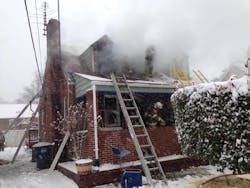Until recently, the Mid-Atlantic region faced a relatively tough winter that resulted in an unusually high fire volume. The Prince George’s County Fire and Emergency Medical Services Department (PGFD) in Maryland has traditional and non-traditional prevention, public education and community risk reduction models to combat the volume and fire-load; however, significant cold and snow can be wearisome and likely have a dampening physiologic and psychological effect on just about any prevention efforts.
Thursday, March 5, 2015, proved to be one of those trying days, with approximately 6 to 8 inches of new snowfall, temperatures falling into the teens, and three “bread-and-butter” house fires in just 7 hours:
- Jefferson Street – City of Hyattsville; 2 p.m.; smoke showing from the second floor
- Rustic Hill Drive – City of Bowie, 7:45 p.m.; fire showing from the garage
- Musket Court – Allentown/Fort Washington area; 8:30 p.m.; fire showing from the rear
PGFD Basics
All fire/EMS operations are coordinated through the County fire/EMS department. There are 27 independent municipalities and 37 volunteer fire/EMS corporations in the county. The PGFD runs a typical house (box) assignment with four engines, two ladder trucks, a third special service, an ambulance, and two battalion chiefs. A “working fire” dispatch brings a safety officer, an EMS duty officer, and a paramedic unit. During significant weather events, the department directs the Public Safety Communications Center (PSCC) to reduce unconfirmed or questionable calls to lesser responses. All three of these house fires ran full box assignments.
Jefferson Street
At 2 p.m., a box alarm was dispatched for smoke coming from a single-family residence in the City of Hyattsville. Firefighters arrived on scene to find a 1½-story Cape Cod-style house with smoke showing from the second floor.
Unsure of the exact location of the fire, initial-arriving units searched and attempted an aggressive interior attack up the interior stairs. The first-in crew from Hyattsville Station 801 was required to back out as their initial 1 ¾” line burned through from drop-down. By then, fire was showing from the second-floor windows sides A and C.
While searches continued, the burned line situation, coupled with fire now showing, set up a coordinated “transitional” or “resetting” attempt from the next-arriving engine. The incident commander, Volunteer Division Chief Randy Kuenzli, directed Division 1 and 2 units to shelter while the reset was attempted from the rear deck. During the 20 to 30 seconds that the exterior reset was deployed, interior crews remedied the attack line issue. As soon as the transition occurred and the exterior line was shut down, interior crews advanced the interior attack line to finish the job.
Truck companies opened up interior knee walls a little ahead of the hoseline, prompting a few anxious moments of unchecked extension. Crews quickly recovered from both the burnt hoseline and the early knee-wall ventilation in order to extinguish all visible fire in about 20 minutes.
The transitional attack used at Jefferson Street was just one more example proving the realities of science and flow paths, and disproving the myths of “frying” or “pushing the fire” by the use of an exterior attack.
At the time of this writing, PGFD fire investigators list the cause as “under investigation,” with fire loss totaling $100,000.
Rustic Hill Drive
At 7:45 p.m., a box alarm was dispatched for fire in a garage attached to a single-family residence in the City of Bowie. Firefighters arrived on scene to find fire showing from the garage of a ranch-style house, with smoke showing from most of the attic.
Firefighters from Bowie Station 819 advanced a 1¾” line to the garage and initiated a quick knockdown of the garage fire. The ceiling had already failed in the garage, exposing the open 1,600-square-foot attic space. Within 30 seconds, fire broke through the roof of the adjacent kitchen, while additional arriving firefighters attempted to cut off the fire.
With large amounts of “paper” insulation in the attic, fire continued to overwhelm firefighters, and a rear portion of the roof structure collapsed. The incident commander, Volunteer Chief Jeff Miller, evacuated firefighters on the order of the safety officer. Firefighters regrouped and re-strategized to extinguish the fire and mop up. Ultimately the entire roof of the home was lost.
Initial tactics to attack the fire from the garage are consistent with new tactical procedures to put water on the fire in the quickest and safest way possible. The tactics worked at Jefferson Street and, as you’ll see below, at Musket Court. Unfortunately, the fire at Rustic Hill had already extended into concealed spaces at a volume that overwhelmed the available water. Had the initial firefighters stretched that line in the front door, it is possible they would have been caught in the roof collapse. Due to weather conditions, a Fire Task Force was called to provide fresh relief crews on the scene.
At the time of this writing, PGFD fire investigators list the cause as “under investigation,” with a fire loss totaling $150,000. There is no indication of anything but an accidental fire.
Musket Court
At about 8:30 p.m., a box alarm was dispatched for a house fire in the Allentown/Fort Washington southern area of the county. Firefighters conducting the 360-walkaround found a significant fire involving the basement, first floor and an attached deck of a second-story split foyer residence.
Firefighters from Allentown Road Station 832 advanced a 2” stack-tip line to the rear of the house. Crews operated the line from the side, flanking the deck and rear of the house to extinguish the deck and siding fire. Due to the instability of the deck above, subsequent lines were ordered in the front door to extinguish fires in the basement and on the first floor. The incident commander, Battalion Chief Steve Kling, with the assistance of other chief officers, ordered and directed backup lines and truck company work through the front door and over ladders.
Additional crews were deployed to complete the search and as backup for the deployed attack lines. Truck 825 stood by on side Alpha as the rapid-intervention crew. Two home occupants were evaluated by PGFD paramedics and transported to a local hospital with minor smoke inhalation.
At the time of this writing, PGFD fire investigators list the cause as “under investigation,” with a fire loss totaling $100,000.
Synopsis
Weather conditions were challenging at all three fires. While it was actively snowing at Jefferson Street, temperatures had dropped to about 10 degrees by the time Musket Court was dispatched. As is routine with regional mutual-aid partners, firefighters from all over Prince George’s County were joined by firefighting and fill-in crews from various Washington-area departments, including Montgomery and Anne Arundel counties in Maryland and Fairfax County in Virginia.
With the deployment of nearly 150 firefighters to three different scenes, there were no firefighter injuries. The fact that every firefighter returned home uninjured speaks volumes to the diligence of everyone involved. Although two citizens were transported on the Musket Court fire, there were no significant civilian injuries this day. There was one non-injury fire department vehicle accident.
All three of these fires presented the opportunity for firefighters to use newly prescribed tactics to better understand fire dynamics and debunk the myths of fire service history. Fortunately, two of the three incidents are science-success stories to tell. Unfortunately, the third incident had advanced to a broad expanse of void space, allowing the undetected/unchecked fire to gain significant headway before the first hoseline could be deployed.
The cultural changes in the fire service today are profound. Flow paths and fire science used to be treated as “just science”—but finally, it’s a reality.
Sidebar: Prince George’s County Fire and Emergency Medical Services Department
Chief: Marc Bashoor
Personnel: 925 career staff; 1,570 volunteers
Stations: 45
Apparatus: 96 engines, 25 towers/trucks, 12 rescue squads, 98 ambulance/medic units, 12 tactical support vehicles
Population: 900,000
Area: 500 square miles






